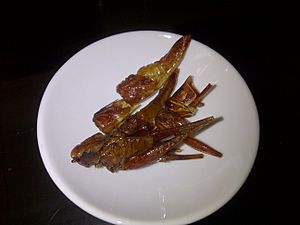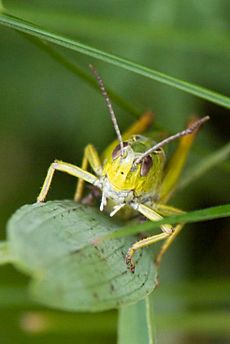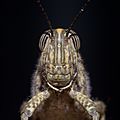Grasshopper facts for kids
Quick facts for kids Grasshopper (Caelifera)Temporal range: late Permian – Recent
|
|
|---|---|
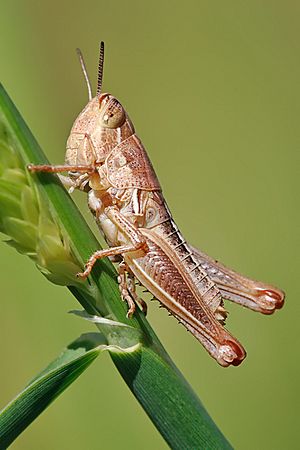 |
|
| Immature grasshopper | |
| Scientific classification | |
| Kingdom: | |
| Phylum: | |
| Subphylum: | |
| Class: | |
| Order: | |
| Suborder: |
Caelifera
|
Grasshoppers are amazing insects that belong to a group called Caelifera. This group also includes locusts. There are about 11,000 different kinds, or species, of grasshoppers in the world! Most of them, around 10,000 species, are part of a family called Acrididae.
Sometimes, people call grasshoppers "short-horned grasshoppers" to tell them apart from bush-crickets or katydids. This is because grasshoppers have shorter antennae than crickets. Some grasshopper species can even change their color and behavior when there are many of them living close together. When this happens, they are called locusts.
Grasshoppers usually love to munch on grasses, leaves, and cereal crops. But many grasshoppers will eat all sorts of plants. Some grasshoppers eat from several different plants in one day, while others stick to just one plant. There's even one species of grasshopper that only eats a single type of plant!
Contents
What Makes Grasshoppers Special?

Grasshoppers have antennae that are usually shorter than their bodies. They also have short parts called ovipositors, which females use to lay eggs. Their mouths have strong pinchers, or mandibles, that help them cut and tear their food.
Many grasshoppers make sounds that you can easily hear. They do this by rubbing their strong back legs against their front wings or their body. This is called stridulation. If they have ears, called tympana, these are usually found on the sides of their first body segment.
Their back legs are typically long and very strong. This makes them excellent at leaping! Most grasshoppers have wings, but their back wings are thin and clear, while their front wings are tougher and not really used for flying.
Female grasshoppers are usually bigger than males. They have two pairs of small, triangle-shaped parts at the end of their bodies. These are used to dig into the ground when they lay their eggs. Male grasshoppers have a single plate at the end of their bodies.
It's easy to mix up grasshoppers with Ensifera (crickets), which are another group of insects. But there are many differences! For example, grasshoppers have fewer segments in their antennae than crickets. Crickets have antennae with at least 20 to 24 segments, while grasshoppers have fewer. Also, their ears are in different places, and they make sounds in different ways. Scientists believe that grasshoppers and crickets split into separate groups a very long time ago, around the time of the Permian and Triassic periods.
More About Grasshoppers
Grasshoppers as Food
In some countries, people eat grasshoppers! They are a good source of protein. For example, in southern Mexico, a type of grasshopper called chapulines is popular because it's full of protein, minerals, and vitamins.
People often collect grasshoppers at dusk, using lamps or electric lights and special nets. Sometimes, they are soaked in water for a day. After that, they can be boiled, dried in the sun, or fried. People often flavor them with spices like garlic, onions, or chili, or squeeze lime juice on them. They can be used in soups or as a filling for different dishes. You can find them in many food markets in Central and Southern Mexico.
In some Chinese food markets, like the Donghuamen Night Market, you might even see them served on skewers!
It's important to be careful if you ever try raw grasshoppers, as they might carry tiny tapeworms.
In parts of Africa, grasshoppers and other insects are an important food source. They add protein and fats to people's diets, especially when food is scarce. They are often used in soups. The "grasshoppers" eaten in Uganda are called nsenene, but these are actually bush crickets, also known as katydids.
In some Middle Eastern countries, grasshoppers are boiled in hot water with salt, then left in the sun to dry. After that, they are eaten as snacks.
Grasshoppers are also a food source for many animals in their natural environment. Animals like foxes, moles, birds, mice, shrews, skunks, and ground squirrels all enjoy eating grasshoppers.
Locusts: Swarming Grasshoppers

Locusts are actually several types of short-horned grasshoppers from the family Acrididae. What makes them special is that they can sometimes form huge groups called swarms. These swarms can be very destructive and move together in a coordinated way.
This means these grasshoppers have two main phases: a solitary phase where they live alone, and a gregarious (swarm) phase. Locust swarms can cause massive damage to crops, which can be a big problem for farmers.
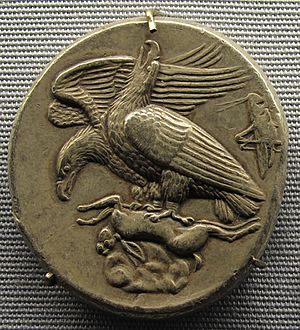
How Grasshoppers Hide: Camouflage
The colors of different grasshopper species often depend on where they live. Many species are perfectly colored to blend in with green fields and forests. This helps them hide from animals that want to eat them. Other grasshoppers have adapted to dry, sandy places. Their colors match the dry dirt and sand, helping them disappear into their surroundings. This is called camouflage.
Grasshoppers in Stories and Movies
- A very old story-teller named Aesop (who lived around 620–560 BC in Ancient Greece) told a famous tale called The Ant and the Grasshopper. In this story, the ant worked hard all summer to get ready for winter, collecting food and building a shelter. The grasshopper, however, spent the summer playing. When winter arrived, the ant was prepared, but the grasshopper had nothing. He begged the ant for help, but the ant refused, and the grasshopper starved.
- In the 1998 movie A Bug's Life, the heroes are a colony of ants, and the main bad guys are grasshoppers. The movie seems to be inspired by Aesop's fable, The Ant and the Grasshopper. In the movie, the main grasshopper villain is eaten by a bird, just like the grasshopper in the fable faced a bad end.
Related Insects
Images for kids
-
Ensifera, like this great green bush-cricket Tettigonia viridissima, somewhat resemble grasshoppers but have over 20 segments in their antennae and different ovipositors.
-
Frontal view of Egyptian locust (Anacridium aegyptium) showing the compound eyes, tiny ocelli and numerous setae
-
Millions of plague locusts on the move in Australia
-
Cottontop tamarin monkey eating a grasshopper
-
Grasshopper with parasitic mites
-
Detail of grasshopper on table in Rachel Ruysch's painting Flowers in a Vase, c. 1685. National Gallery, London
-
Sir Thomas Gresham's gilded grasshopper symbol, Lombard Street, London, 1563
-
Sweet-and-salty grasshoppers dish in Japan (Inago no Tsukudani)
-
Gaudy grasshopper, Atractomorpha lata, evades predators with camouflage.
-
Lubber grasshopper, Titanacris albipes, has deimatically coloured wings, used to startle predators.
-
Leaf grasshopper, Phyllochoreia ramakrishnai, mimics a green leaf.
-
Painted grasshopper, Dactylotum bicolor, deters predators with warning coloration.
-
Spotted grasshopper, Aularches miliaris, defends itself with toxic foam and warning colours.



